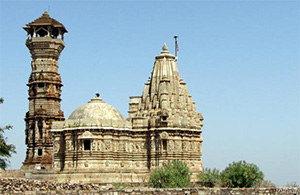
- Rajasthan Travels
- Email: [email protected]
- Phone: +91-11-25590701
Chittorgarh Fort is the largest fort in India and the grandest in the state of Rajasthan. It is an World Heritage Site. The fort, plainly known as Chittor, was the capital of Mewar and is today situated several kilometres by road south of Bhilwara. It is situated on the left bank of the Berach waterway and is connected to the new town of Chittorgarh created in the fields after 1568 AD when the fortification was forsaken in light of presentation of ordnance in sixteenth century, and subsequently the capital was moved to more secure Udaipur, placed on the eastern flank of Aravalli hill range. Chittorgarh provides plenty of accommodation options. One can find several budget, mid-range and luxury hotels.


Kirti Stambh or "Tower of Fame" is located at Chittorgarh fort. This tower of 22 meter stature goes once more to 12th century. A forcing five feet high statue of Adinathji pulls in the guests monstrously. The seven story structure has a perplexing stairway of 54 steps and is enhanced with figures from Jain spots of love. The tower shows Solanki engineering style and is 30 feet broad at the base and contracts down to 15 feet at the top. Jain models add magnificence to the outer surface of the tower. The Jain tower has a complex structure with carvings, corners and overhangs. The carvings are of the naked Jain teerthankars. A perception corridor is spotted on the top floor of the tower and gives extraordinary perspectives of the stronghold and of the encompassing region.
Rana Kumbha Palace is a piece of number of legends. These legends are connected with Queen Padmini of Chittorgarh. The royal residence is additionally named after the best of the Sisodias. The area of the royal residence likewise has its companionship with the historical backdrop of the spot. It is in this area where Padmini conferred Jauhar or self immolation. The self immolation was additionally joined by 700 adherents to spare honor. This was carried out as an approach to abstain from getting disrespected at the hands of the adversaries. On the other hand, after much exertion, archeologists still haven't uncovered the root subterrain rooms where this demonstration was performed. The royal residence was manufactured by Bappa Rawal in 734 AD. He was the organizer of the House of Mewar.


Padmini's Palace, the recent home of Rani Padmini the exemplification of excellence, valor and effortlessness, is arranged inside the magnificent Chittorgarh Fort. A delightful lotus lake is located close-by the castle. It is accepted that it was in this royal residence the Sultan Alauddin Khilji view the impression of the wonderful Rani Padmini in a mirror which was placed in the fundamental lobby of castle. The building style is magnificent, the surroundings are beautiful. The famous sacrosanct Neelkantha Mahadev Temple is a fascination close-by. Chittorgarh is the exemplification of Rajput pride, sentiment and soul. It resonates with history of bravery and reparation, which is clear as it echoes with the stories sung by the Bards of Rajasthan.
The Vijay Stambh (Tower of Victory) is spotted in Chittorgarh, which was constructed by Rana Kumbha in 1440 AD to commend his triumph over Mahmud Khilji of Malwa. It is a decent storied structure, with a forcing height of 37 meter, which is a finest case of the celebrated internationally Rajput style of structural planning. It is adjoining the Mahasati region inside the Chittor fort. This spot is utilized as the cremation ground for the male parts of the illustrious gang. The encompassing territory is spotted with Sati Stones meaning the tributes made by the ladies on their spouses' pyres. On the tower Hindu Gods and Goddesses images are marked. After reaching at the top of tower, anyone can see a great and unique view of the whole city.
